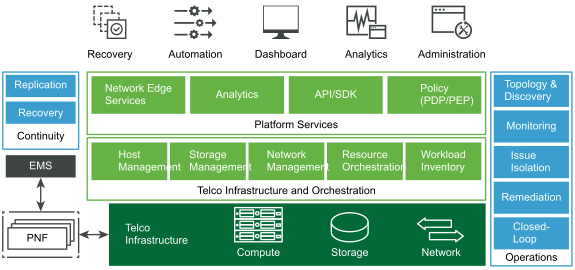The Telco Cloud Infrastructure platform implements the conceptual architecture that is outlined and defined at a high level through the logical building blocks and core components.
The Telco Cloud Infrastructure platform is an evolution of the NFV architectural framework, based on the extensive customer deployment and the continued development of standards organizations such as the European Telecommunications Standards Institute (ETSI). The Telco Cloud Infrastructure platform provides a comprehensive, service-oriented solution, leveraging a cloud computing model that allows ubiquitous, programmatic, on-demand access to a shared pool of compute, network, and storage resources. The solution is integrated with holistic operations management and service assurance capabilities, empowering the CSP to rapidly deliver services while ensuring their quality. With a fully integrated VIM, the same infrastructure delivers a myriad of telecommunications use cases and facilitates reusability of the service catalog based VNFs.
The following diagram maps the conceptual architecture to a logical view for the Telco Cloud Infrastructure platform:

The Telco Cloud Infrastructure platform delivers a complete integrated solution that is rigorously tested to ensure compatibility, robustness, and functionality. The components that build the solution are currently deployed across many industries and scenarios. The Telco Cloud Infrastructure software components can be used in various ways to construct a comprehensive, end-to-end solution that meets the business goals of CSPs. This document discusses how components can be used to create the Telco Cloud Infrastructure architecture.
Logical Architecture Components
The Telco Cloud Infrastructure platform consists of three core domains of functions, core infrastructure, infrastructure orchestration, and operations management. At the core infrastructure, ESXi is used to virtualize the compute resources, NSX-T Data Center to provide virtual networking, and vSAN for storage. The core infrastructure virtualization layer provides the following functions:
-
Physical Resource Abstraction: By using the software component layers between the physical hardware and the VNFs, physical resources are abstracted. The physical resource abstraction provides a standardized software-based platform for running workloads, regardless of the underlying hardware. If the CSP uses certified physical components, the carrier can deploy workloads at the point of presence (POP), distributed, or centralized data center.
-
Physical Resource Pooling: Physical resource pooling occurs when Telco Cloud Infrastructure presents a logical virtualization layer to workloads, combining the physical resources into one or more resource pools. Resource pooling together with an intelligent scheduler facilitates optimal resource utilization, load distribution, high availability, and scalability. This allows for fine grained resource allocation and control of pooled resources based on specific workload requirements.
-
Physical Resource Sharing: To benefit from cloud economies, the resources that are pooled and abstracted by the virtualization layer must be shared between various network functions. The virtualization layer provides the functionality that is required for VNFs to be scheduled on the same compute resources, collocated on the shared storage, and to have the network capacity divided among them. The virtualization layer also ensures fairness in resource utilization and usage policy enforcement.